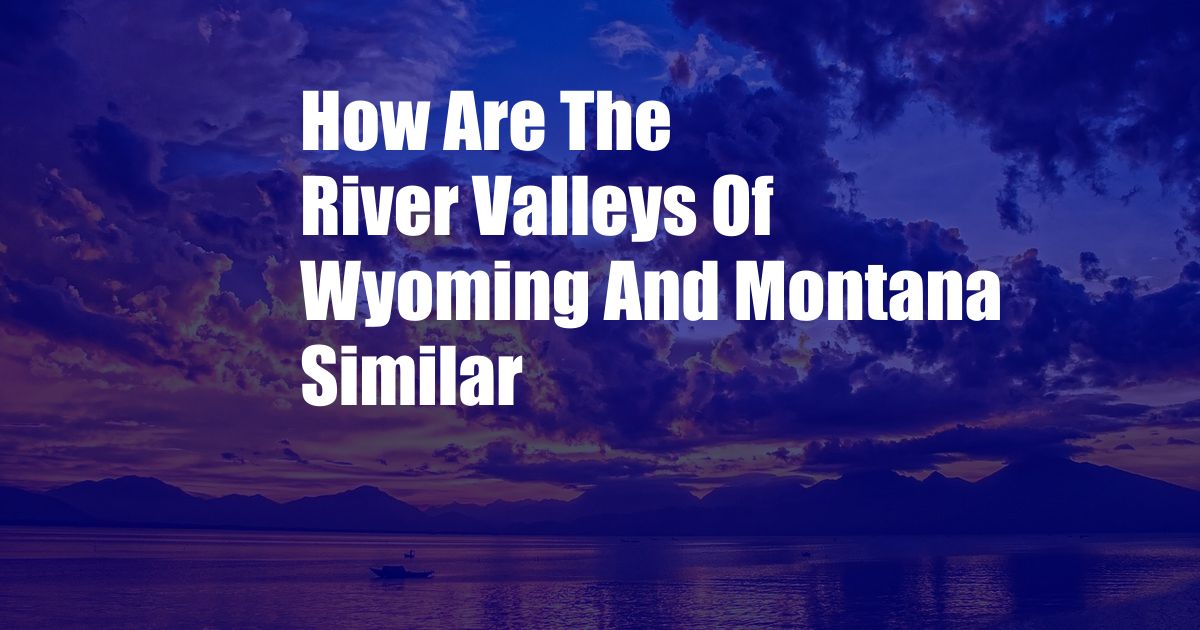
Discover the Striking Similarities Between the River Valleys of Wyoming and Montana
Imagine standing on the banks of the mighty Yellowstone River, gazing at the sheer cliffs and lush valleys that flank its emerald-green waters. Now, picture yourself transported to the equally breathtaking Gallatin Canyon, where the Gallatin River meanders through a similar landscape of towering mountains and verdant meadows. While Wyoming and Montana are neighboring states, their river valleys share a remarkable kinship that extends beyond geographical proximity.
These river valleys are not only shaped by the relentless forces of nature but also interwoven with the rich history and culture of the region. From Native American tribes who once hunted and fished in these valleys to modern-day adventurers seeking thrills and tranquility, the river valleys of Wyoming and Montana continue to captivate the hearts and minds of those who encounter them.
Geology: The Sculpting Forces Behind the Valleys
To understand the similarities between the river valleys of Wyoming and Montana, we must delve into the geological forces that have shaped them over millions of years. Both regions were subjected to intense tectonic activity during the Laramide orogeny, resulting in the uplifting of the Rocky Mountains. As these mountains rose, they disrupted the drainage patterns of the area, creating a series of vast valleys.
Another key geological process in shaping these valleys was the scouring action of glaciers during the Ice Ages. Massive ice sheets covered much of the region, carving out deep, U-shaped valleys as they retreated. These valleys, now home to the meandering rivers of today, bear the unmistakable imprint of the glaciers that once dominated the landscape.
Climate: A Symphony of Seasons
The river valleys of Wyoming and Montana share a similar climate that is characterized by four distinct seasons. Summers are typically warm and dry, with occasional thunderstorms, while winters are long and cold, bringing significant snowfall to the mountains.
Spring and fall offer transitional periods, with moderate temperatures and variable precipitation. These seasonal changes create a vibrant tapestry of colors and textures in the valleys, from the vibrant reds and oranges of autumn to the delicate pastels of springtime.
Ecosystems: A Tapestry of Life
The river valleys of Wyoming and Montana are home to an astonishing array of plant and animal life. The moist riparian zones along the rivers support lush forests of cottonwood, aspen, and willow, providing shelter and sustenance for a myriad of species.
Upland areas are dominated by grasslands, which provide grazing grounds for bison, elk, and pronghorn antelope. The rugged mountains that encircle the valleys are home to grizzly bears, black bears, wolves, and mountain lions, completing the intricate web of life that thrives in these valleys.
Culture and History: A Crossroads of Time
The river valleys of Wyoming and Montana have been home to human habitation for thousands of years. Native American tribes, such as the Crow, Shoshone, and Blackfeet, established seasonal hunting and fishing camps in the valleys, leaving behind a rich legacy of cultural artifacts and traditions.
In the 19th century, the valleys played a pivotal role in the westward expansion of the United States, serving as important transportation routes for explorers, trappers, and settlers. Today, the valleys are dotted with charming towns and ranches, preserving the region’s unique heritage.
Exploring the River Valleys: A Guide for Adventure
The river valleys of Wyoming and Montana offer countless opportunities for outdoor recreation and adventure. Hiking trails weave through pristine forests, leading to hidden waterfalls and panoramic viewpoints. Float trips along the rivers provide a leisurely way to experience the valleys’ natural beauty and abundant wildlife.
For those seeking a more adrenaline-pumping experience, whitewater rafting on the Gallatin River is a thrilling adventure. The valleys are also popular destinations for fishing, with the Yellowstone and Gallatin rivers renowned for their world-class trout populations.
Tips for Enhancing Your River Valley Experience
Here are a few tips to make your exploration of the river valleys of Wyoming and Montana even more enjoyable:
- Visit in the shoulder seasons (spring or fall) for fewer crowds and more favorable weather.
- Bring plenty of water and snacks, as there may not be readily available food or drink while hiking or floating.
- Be prepared for all types of weather, including rain, snow, and strong winds.
- Respect the wildlife and observe them from a distance.
By following these tips, you can maximize your adventure and create lasting memories in these breathtaking river valleys.
Frequently Asked Questions
Q: What are the major differences between the river valleys of Wyoming and Montana?
A: While the river valleys of Wyoming and Montana share many similarities, there are a few notable differences. The valleys in Wyoming tend to be wider and have more gradual slopes, while the valleys in Montana are often narrower and more rugged.
Q: Can you recommend any specific hiking trails in the river valleys?
A: Yes, here are a few popular hiking trails in the river valleys of Wyoming and Montana:
- Hell Roaring Trail (Yellowstone National Park, Wyoming)
- Indian Creek Trail (Gallatin Canyon, Montana)
- Six Mile Creek Trail (Bighorn Canyon National Recreation Area, Wyoming)
- Refuge Point Trail (Yellowstone National Park, Montana)
Conclusion
The river valleys of Wyoming and Montana offer a captivating blend of natural beauty, rich history, and outdoor adventure. Whether you seek solitude in pristine wilderness or the excitement of exploring a vibrant landscape, these valleys will undoubtedly capture your imagination.
As you delve deeper into the river valleys of Wyoming and Montana, I encourage you to discover the unique stories and experiences that await you. Share your adventures and insights, and let the allure of these valleys inspire you to appreciate the wonders of our natural world.
Do you have any questions or experiences to share about the river valleys of Wyoming and Montana? Leave a comment below and let’s continue the conversation.